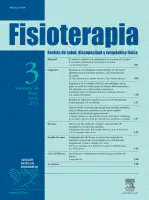Musculoskeletal problems in physiotherapists
Problemas músculo-esqueléticos en los fisioterapeutas

Abstract
The aim of this study was to know what types of work-related musculoskeletal disorders physiotherapists suffer during the performance of their professional activities. A cross-sectional descriptive study was conducted using the Nordic Questionnaire as modified by the UK Health and Safety Executive in order to gather data on musculoskeletal problems in a sample of 41 physiotherapists. Furthermore, level of mechanical load suffered by the physiotherapists and static compression forces acting on the L4/L5 and L5/S1 intervertebral discs was calculated according to their morphological characteristics during the performance of four specific professional activities. This was done with the 3D Static Strength Prediction Program (3DSSPP™) software that makes it possible to mechanically model the locomotor apparatus. The results of the survey revealed that physiotherapists experience muscle and joint aches and pains during their occupational activities (i.e., upper back: 74.36%; low back: 72.50%; neck: 70%). Given the input data of the four specific professional activities, the mathematical modeling of the posture adopted during their professional activity revealed that especially the female population of greater stature and weight cannot support the net muscle moment requirements in the principle joints without risk of musculoskeletal injury. Furthermore, the intervertebral compression force in some occasions exceeds the injury threshold value. It can be suggested that the risk of work-related musculoskeletal disorders among physiotherapists is very high. Therefore, it is necessary to organize and design their workspace using ergonomics criteria and to improve the design of the work setting elements of the physiotherapists.